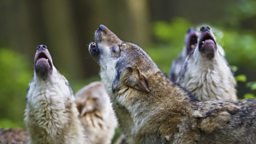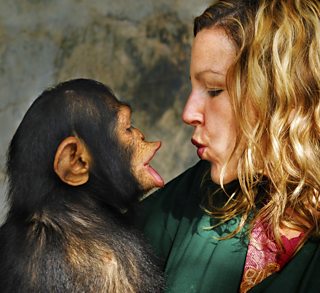How do animals talk?
Why do wolves howl and dolphins whistle? Do animals have “language”? And can we talk to them?
In an animal special of Radio 4's Word of Mouth, Michael Rosen chats to expert Dr Arik Kershenbaum – a zoologist and the author of Why Animals Talk: The New Science of Animal Communication – about the latest research on how and why different types of creatures communicate.
Word of Mouth

With Michael Rosen.
All animals communicate
“Communication is something that animals do; it’s fundamental to what it is to be an animal,” says Arik.
A lot of the time that communication is vocal. “Sound is just a really good way to get your message across on this planet,” states the zoologist. We also see animals communicate with vision, smell, vibration, and even electric fields. “But it’s really sound that has taken over, has become the dominant way for complex communication.”
The fundamental reason that animals make so many vocal signals is to influence the behaviour of other animals – in order to survive and thrive.
Can we use the word “language” when it comes to animals?
Some people define language in a way that purposely excludes other animals, says Arik, so that only humans have what they call language.
His definition is different: “It would be a communication that has the potential to convey an unlimited number of concepts.” There are animals that communicate a lot of information like dolphins and chimpanzees, those that communicate a relatively large amount like dogs and cats, and animals that communicate less. Communication is clearly on a continuum.
Is there value in saying what we do as humans is qualitatively different? “I think there is,” argues Arik, “because there don’t seem to be any other animals that have that really unbounded communicative ability.”
We can only understand animal communication by studying them in the wild

Until a century ago, most people thought animals were very simple and just responding to stimuli that they were given, Arik explains. “It wasn’t really until people started studying animals in the wild, in the way that they truly behave, that there were advances in understanding what this communication is all about.”
Honey bees were the first animals to be studied in this way. “Here’s a creature that has a clear need to convey information to other members of its group, but you won’t see that unless you’re actually studying them in the process of collecting nectar and bringing it back to the hive,” states the zoologist.
Now, Arik and his counterparts place recording devices in natural habitats, in order to record animals and later interpret the data they collect. By studying animals in the wild they can start to ask the question, why have animals evolved to make the sounds that they do?
Why do wolves howl?

Wolf howls are a form of animal communication that Arik and colleagues have studied in great detail. They use algorithms to analyse the different types of howls and their meaning.
Human speech is only intelligible at close range. Apart from, of course, yodelling..."Dr Arik Kershenbaum
“It’s certainly clear that they are howling to get them what they need,” says the zoologist. “Wolves don’t hunt on their own, so they need to make sure they know where all the other wolves of the pack are… Howling also has a role in deterring other wolves from their territory. They need to perhaps find a mate.”
Scientists are also convinced that one of the roles of howling is simply to strengthen the social bonds within the group. “That kind of social role of communication is very important in many species.”
Wolves have dialects
“Wolves are very broadly distributed across the world and they sound very different in each of those places,” Arik explains. European wolves have a very distinctive low, flat howl whereas Arctic wolves have a highly modulated howl, changing in pitch.
“We don’t know with wolves in fact whether those dialects have arisen in the same way that human dialects arise – just random copying errors diverging – or whether they actually have an adaptive benefit,” he states. Does the Arctic wolf’s howl go up and down because they live in the snowy tundra as opposed to the forests of Europe? “We don’t know,” says Arik. “Just one of the many questions we have about animal communication.”
Yodellers and wolves have a lot in common
Some animals use sound over very long distances. “Wolves can be heard from up to ten kilometres away,” states Arik. He and his colleagues use this to their benefit. They howl to the wolves – and wait for a response – in order to locate the animals. “Because this is a long-range signal… like shouting across a football field, it doesn’t really matter that much whether your howl is a really good impression or not,” says the researcher. At a range of a kilometre or two the wolves probably can’t tell the difference!
There are, also, many animals that communicate vocally over short distances, like us. “Human speech is only intelligible at close range,” he says. Apart from, of course, yodelling: a nice analogy with wolf communication. Yodelling has a single note that goes up and down in pitch, that conveys information reliably over long distances – in exactly the same way as a wolf’s howl.
Dolphins whistle by recycling the air in their head

“Dolphins use three main different vocal signals,” says Arik. Firstly, whistles. “They actually recycle their air inside their head, and the sound comes out of their forehead,” he explains. The blowhole remains closed so as not to use up precious breath when they’re underwater.
“These whistles are in many ways very similar to wolf howls,” says the zoologist. They are long-distance signals, with pitch that varies up and down. “We do know that different whistles take on different meanings.”
Dolphins also communicate using clicks and buzzing sounds, but scientists know very little about these and the other forms that dolphins use to communicate.
Dolphins have names
“Each dolphin has a particular, specific whistle that represents itself,” says Arik. Dolphins have names.
“One of the things that is really important for really complex communication is understanding about yourself and others,” says the expert. You can howl for emotional reasons, because you’re hungry or scared, but you can only really communicate complex information if you realise there is information you have, that others don’t. “Dolphins are presumably capable of this,” he says. “They do seem to have a sense of individual identity.”
Many animals can express emotion
You can determine an awful lot about an animal’s cognitive state from listening to their communication, says Arik. “If nothing else, there’s the phenomenon of screaming. Screaming is extremely common in the animal world.” When frightened, everything from dogs to deer to monkeys will make a very similar sort of “fear sound”.

Use of syntax was thought to be specific to human language, but it’s actually found all over the animal world."
“There is a tendency to believe that emotions are something that’s special to us. In fact, emotions are what we have in common with all animals.” What distinguishes humans from animals is our rationality.
Many animals have the “building blocks” of language
There are many aspects of communication that we have inherited from our ancestors. Speech – vocal production – is a simple example. But there are also more surprising and subtle things, like our use of syntax. This was thought to be specific to human language, but it’s actually found all over the animal world, says Arik.
From trying to teach animals like parrots and chimpanzees language, scientists have learned that they have a lot of the building blocks already: the ability to understand word order, to mimic, to learn through observational technique. All these came together in humans to produce our language, but we can see those elements present in many different species too. “It’s clearly much more widespread than people used to think,” states the expert.
“There was a discrete shift when human language evolved,” says Arik. It is more complex than any other animal communication. But much of what we do when we communicate is actually very simple, and no different from animals. “On the one hand we’ve bolted on this extra capability of language, but we’ve bolted it on on top of a creature that has all the same stuff that all these other animals have.”
Will we be able to talk to animals?
“We do talk to our animals,” says Arik. The question is, how do we talk to them? “We can talk to our pets by projecting our own language on to them and imagining that they’re speaking in the same way, or we can talk to them in their way; we can talk to them in their language, in the way that they’ve evolved to understand communication.”
This, he argues, is much more satisfying. “What I don’t particularly want to do is talk to animals in ways that they don’t talk.” We must not view them as “little furry humans,” he stresses. “That is not the way that they evolved and is not who they are.”
-
![]()
Listen to Word of Mouth: How animals talk
Michael Rosen hears from zoologist Arik Kershenbaum about the latest research on how and why different types of animals communicate, from wolves howling to dolphins whistling: a world of soundscapes. He also explains how animal communication can help to shed light on the human variety.

More words from Radio 4
-
![]()
Word of Mouth
Radio 4's popular series exploring the world of words and the ways in which we use them, with Michael Rosen.
-
![]()
Women and words: why language matters
Nikki Bedi and Professor Deborah Cameron explore how sexism is reflected in the English language.
-
![]()
Dropping the mic and jumping the shark
Shedding light on the surprising origins of some modern-day phrases,
-
![]()
Are you grammatically gormless or a punctuation perfectionist?
Apostrophes have caused more arguments, disputes and unfettered violence than every family event put together. Test your knowledge with our popular apostrophe quiz!





